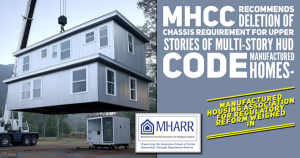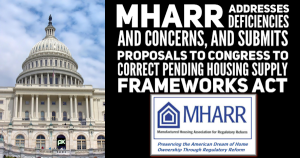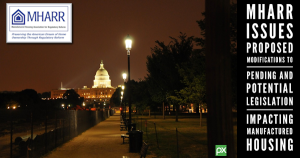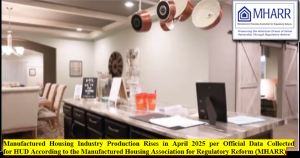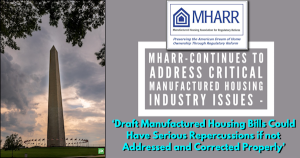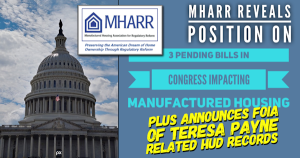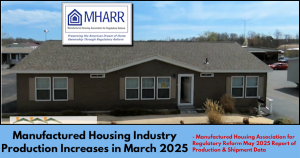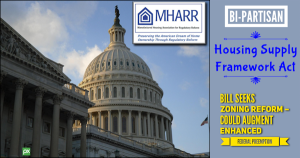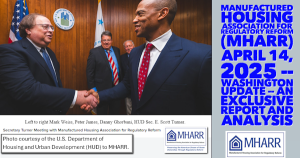“INVASION OF THE BUILDING CODE SNATCHERS”
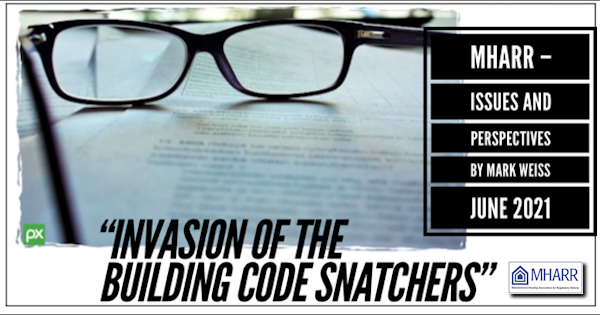
In the classic film noir, “Invasion of the Body Snatchers,” space aliens attempt to take over the Earth by replacing real people with robot-like replicas. With those replicas, they seek to change the composition and fundamental nature of Earth’s population. While the film’s premise is far-fetched, something oddly similar — in principle — is beginning to happen with respect to the HUD Code standards for manufactured housing. And, like the movie’s fictional alien “invasion,” this veiled effort to transform the fundamental nature of the HUD Code, must be stopped before it leads to real-world harm for both the manufactured housing industry and the American consumers (including lower and moderate-income families) who rely on the non-subsidized affordability of HUD Code manufactured homes.
To start with, it’s crucial to recognize and acknowledge that the HUD Code standards (and their related enforcement mechanisms), as they have existed for the past 45 years, are unique within the housing industry. And that is not accidental. Their unique character, both individually and cumulatively, is a product of the unique nature and objectives of the laws (i.e., the National Manufactured Housing Construction and Safety Standards Act of 1974 and the Manufactured Housing Improvement Act of 2000) that authorize, require and govern their adoption. Those laws, in all of their various provisions and particulars – as is made clear on their face — were specifically and intentionally structured and enacted by Congress to “protect the quality, durability, safety and affordability of manufactured homes” and to “facilitate the availability of affordable manufactured homes and … increase homeownership for all Americans.” (Emphasis added). Consequently, it is beyond any reasonable debate that Congress wanted a unique building code specifically for manufactured homes that would protect, facilitate and maintain their status as the nation’s most affordable source of non-subsidized housing and homeownership.
And, true to this clearly-stated, overriding objective, the Federal Manufactured Housing Construction and Safety Standards adopted by HUD over the course of the past four decades-plus, have been – and are, in fact – unique in multiple respects. First, they comprise the only uniform federal building code of general applicability to residential construction. Second, they are enforced through a uniform, nationwide regulatory system, which does not vary. Third, as the only federal residential building code, they are the only residential building standards that by express statutory mandate, are federally preemptive. Fourth, they are the only building standards that by express federal statutory mandate, are specifically required to balance protection with affordability, in order to maintain the inherent purchase price affordability of manufactured homes. And, fifth, by regulatory mandate (which carries the force of law), they must, “to the maximum extent possible,” establish performance criteria (as contrasted with prescriptive requirements), again to promote and ensure the greatest degree of purchase price flexibility and affordability for homebuyers consistent with the overriding purposes and objectives of federal manufactured housing law.
At a relatively early point, however, it became apparent — especially to the industry’s smaller, independent manufacturers — that this unique regulatory system was not functioning as designed, and that this failure, due in part to the broader industry’s unwillingness to aggressively demand full compliance with federal law, was harming those smaller, independent businesses the most. This led directly to the formation of MHARR to fulfill the need for national representation of the industry’s production sector, and to aggressively promote, seek and demand full program compliance with all relevant aspects of federal law. Thereafter, and during the 36 years since that time, MHARR has functioned as a guardian of the federal law and its affirmative mandate for reasonable, uniform, cost-effective regulation for the benefit of both the industry and consumers.
Consistent with this founding mission, MHARR has always maintained that the HUD Code standards, through their fundamental nature, the process for their adoption, and the process for their enforcement, are an integral part of Congress’ statutory plan, in both the 1974 Act and the 2000 reform law, to ensure, preserve and maintain the fundamental affordability of manufactured housing, now and in the future. Put differently, Congress intentionally structured federal law and the standards adoption and enforcement processes directed by federal law, in order to perpetuate the continuing unique affordability of manufactured housing, both in absolute terms and in relation to other types of homes regulated under other types of standards, codes, and related regulatory structures. The HUD Code standards, consequently, as well as the HUD Code standards development and enforcement processes are, in their fundamental essence and, in order to maintain and preserve the fundamental balance between protection and affordability for consumers, intentionally different from other building codes in both their provisions and their purposes.
This is not to say that specific standards developed by other expert authorities to address individual, discrete aspects of construction or safety, cannot be incorporated by reference into the HUD Code. To the contrary, this has been done since the inception of HUD regulation, as is demonstrated by section 3280.4 of the HUD Code and its extensive list of third-party reference standards. However, before any such standards can be incorporated into the HUD Code, they must meet – and, after the 2000 reform law, must be determined by the Manufactured Housing Consensus Committee (MHCC) and HUD to meet – the specific statutory requirements and criteria of federal manufactured housing law including, but not limited to, their suitability to the unique construction characteristics of manufactured housing and the law’s prime directive to achieve a balance between protection and affordability. If, and only if, a discrete third-party standard meets and satisfies these statutory criteria, can it be referenced in the HUD Code.
Unlike this relatively innocuous incorporation of discrete reference standards, however, there seems to be a growing tendency within the MHCC standards development process, for some members — and others – to seek changes to the HUD Code standards based on standards, concepts, or testing mechanisms (or all three) derived either in whole or in part from other general building codes that are not and have not been developed specifically for manufactured housing under the mandatory criteria and requirements of federal manufactured housing law.
This occurred most recently during the round of MHCC standards revisions addressed by the full Committee on June 10, 2021. Among the proposed standards changes were two proposals – for duct leak testing and increased insulation in certain areas (both opposed by MHARR) – based, in part, on provisions of the International Energy Conservation Code (IECC) maintained by the International Code Council (ICC). And this is not the first time that proposals before the MHCC have sought to replace performance-based HUD Code standards with prescriptive criteria either identical to or derived from general building codes for site-built homes, such as the International Residential Code (IRC).
Put simply, this should not be occurring. Just because a particular provision has landed in some other code that does not address or regulate manufactured housing, does not mean that it should be replicated (or even approximated) in the HUD Code. The IRC and IECC, for example, are not statutorily required to balance cost versus benefit, and together with other general residential building codes, are part of the reason that the cost of construction for manufactured homes, per square foot, is roughly half that of site-built homes according to the most recent annual statistics from the U.S. Census Bureau. Moreover, general building codes like the IECC are not developed and voted-on by manufactured housing experts based on specific HUD Code –centered legislative requirements and cost versus benefit analysis. Instead, as was explained in detail by MHARR in the March 2021 issue of MHARR – Issues and Perspectives, “The Ultimate Battle Against Destructive Energy Regulation,” the IECC, in particular, has (through its most recent 2021 revision) been voted-on and approved by state and local building code officials who generally are not responsible for the regulation of manufactured homes and, in most instances, likely have no specific knowledge related to manufactured homes and manufactured housing consumers. The resulting “standards,” accordingly, are not appropriate for manufactured housing and should not simply be “parachuted” into the HUD Code to take the place of existing provisions that have functioned appropriately and affordably as a base standard.
In particular, the MHCC must constantly be on guard against proposals for new or modified standards (whether based on other building codes or not), that are little more than an attempt by special interests to “legislate” new or additional demand for products or raw materials that they (or their members) sell to the industry. As MHARR has observed many times previously, while uniform federal regulation of the manufactured housing industry is a crucial driver of the unsubsidized affordability of HUD Code homes and an important benefit for the industry and American consumers of affordable housing, the existence of a single federal standard for all manufactured homes, nationwide, is a tempting target for sellers and promoters of goods or products seeking increased sales through regulatory mandates. Consequently, any proposed standard that would require the purchase of new — or more – raw materials, goods, products, or equipment, such as the two proposed standards detailed as examples above, should be subject to extremely close scrutiny by the MHCC (and HUD as well) to ensure the existence of a genuine, proven and legitimate need for change, as well as a clear benefit for homebuyers in excess of any additional cost. And that analysis must proceed from the fundamental proposition that the HUD Code is a base standard that manufacturers and consumers can always exceed on an optional basis, if they wish.
In this regard, an analysis conducted by the National Association of Home Builders has shown that for every $1,000 increase in the retail level cost of a manufactured home, approximately 350,000 potential homebuyers are excluded from the market. This, in itself, demonstrates the critical necessity of maintaining the inherent affordability of manufactured housing. And that affordability derives from and is dependent upon the unique nature of the HUD Code and its mandatory, statutorily-based balancing of protection and cost. In order to preserve that balance, and the status of manufactured homes as the nation’s most affordable non-subsidized housing and homeownership resource, the integrity of the HUD Code as a code exclusively for and specifically tailored for affordable manufactured housing, must be maintained. As a result, both HUD and the MHCC should reject any effort or tendency to infiltrate provisions from other general residential building codes into the HUD standards or enforcement regulations including, most especially (but not limited to) provisions designed to coerce the purchase and utilization of any given supplier – or group of suppliers’ – products. Otherwise, the affordability that those specific manufactured housing-centric requirements were designed to promote and perpetuate will soon disappear, with millions of lower and moderate-income Americans excluded from homeownership in the process – a result that the industry, consumers, nor the nation as a whole, can tolerate.
Mark Weiss
MHARR is a Washington, D.C.-based national trade association representing the views and interests of independent producers of federally-regulated manufactured housing.
“MHARR-Issues and Perspectives” is available for re-publication in full (i.e., without alteration or substantive modification) without further permission and with proper attribution to MHARR.
In the classic film noir, “Invasion of the Body Snatchers,” space aliens attempt to take over the Earth by replacing real people with robot-like replicas. With those replicas, they seek to change the composition and fundamental nature of Earth’s population. While the film’s premise is far-fetched, something oddly similar — in principle — is beginning to happen with respect to the HUD Code standards for manufactured housing. And, like the movie’s fictional alien “invasion,” this veiled effort to transform the fundamental nature of the HUD Code, must be stopped before it leads to real-world harm for both the manufactured housing industry and the American consumers (including lower and moderate-income families) who rely on the non-subsidized affordability of HUD Code manufactured homes.
To start with, it’s crucial to recognize and acknowledge that the HUD Code standards (and their related enforcement mechanisms), as they have existed for the past 45 years, are unique within the housing industry. And that is not accidental. Their unique character, both individually and cumulatively, is a product of the unique nature and objectives of the laws (i.e., the National Manufactured Housing Construction and Safety Standards Act of 1974 and the Manufactured Housing Improvement Act of 2000) that authorize, require and govern their adoption. Those laws, in all of their various provisions and particulars – as is made clear on their face — were specifically and intentionally structured and enacted by Congress to “protect the quality, durability, safety and affordability of manufactured homes” and to “facilitate the availability of affordable manufactured homes and … increase homeownership for all Americans.” (Emphasis added). Consequently, it is beyond any reasonable debate that Congress wanted a unique building code specifically for manufactured homes that would protect, facilitate and maintain their status as the nation’s most affordable source of non-subsidized housing and homeownership.
And, true to this clearly-stated, overriding objective, the Federal Manufactured Housing Construction and Safety Standards adopted by HUD over the course of the past four decades-plus, have been – and are, in fact – unique in multiple respects. First, they comprise the only uniform federal building code of general applicability to residential construction. Second, they are enforced through a uniform, nationwide regulatory system, which does not vary. Third, as the only federal residential building code, they are the only residential building standards that by express statutory mandate, are federally preemptive. Fourth, they are the only building standards that by express federal statutory mandate, are specifically required to balance protection with affordability, in order to maintain the inherent purchase price affordability of manufactured homes. And, fifth, by regulatory mandate (which carries the force of law), they must, “to the maximum extent possible,” establish performance criteria (as contrasted with prescriptive requirements), again to promote and ensure the greatest degree of purchase price flexibility and affordability for homebuyers consistent with the overriding purposes and objectives of federal manufactured housing law.
At a relatively early point, however, it became apparent — especially to the industry’s smaller, independent manufacturers — that this unique regulatory system was not functioning as designed, and that this failure, due in part to the broader industry’s unwillingness to aggressively demand full compliance with federal law, was harming those smaller, independent businesses the most. This led directly to the formation of MHARR to fulfill the need for national representation of the industry’s production sector, and to aggressively promote, seek and demand full program compliance with all relevant aspects of federal law. Thereafter, and during the 36 years since that time, MHARR has functioned as a guardian of the federal law and its affirmative mandate for reasonable, uniform, cost-effective regulation for the benefit of both the industry and consumers.
Consistent with this founding mission, MHARR has always maintained that the HUD Code standards, through their fundamental nature, the process for their adoption, and the process for their enforcement, are an integral part of Congress’ statutory plan, in both the 1974 Act and the 2000 reform law, to ensure, preserve and maintain the fundamental affordability of manufactured housing, now and in the future. Put differently, Congress intentionally structured federal law and the standards adoption and enforcement processes directed by federal law, in order to perpetuate the continuing unique affordability of manufactured housing, both in absolute terms and in relation to other types of homes regulated under other types of standards, codes, and related regulatory structures. The HUD Code standards, consequently, as well as the HUD Code standards development and enforcement processes are, in their fundamental essence and, in order to maintain and preserve the fundamental balance between protection and affordability for consumers, intentionally different from other building codes in both their provisions and their purposes.
This is not to say that specific standards developed by other expert authorities to address individual, discrete aspects of construction or safety, cannot be incorporated by reference into the HUD Code. To the contrary, this has been done since the inception of HUD regulation, as is demonstrated by section 3280.4 of the HUD Code and its extensive list of third-party reference standards. However, before any such standards can be incorporated into the HUD Code, they must meet – and, after the 2000 reform law, must be determined by the Manufactured Housing Consensus Committee (MHCC) and HUD to meet – the specific statutory requirements and criteria of federal manufactured housing law including, but not limited to, their suitability to the unique construction characteristics of manufactured housing and the law’s prime directive to achieve a balance between protection and affordability. If, and only if, a discrete third-party standard meets and satisfies these statutory criteria, can it be referenced in the HUD Code.
Unlike this relatively innocuous incorporation of discrete reference standards, however, there seems to be a growing tendency within the MHCC standards development process, for some members — and others – to seek changes to the HUD Code standards based on standards, concepts, or testing mechanisms (or all three) derived either in whole or in part from other general building codes that are not and have not been developed specifically for manufactured housing under the mandatory criteria and requirements of federal manufactured housing law.
This occurred most recently during the round of MHCC standards revisions addressed by the full Committee on June 10, 2021. Among the proposed standards changes were two proposals – for duct leak testing and increased insulation in certain areas (both opposed by MHARR) – based, in part, on provisions of the International Energy Conservation Code (IECC) maintained by the International Code Council (ICC). And this is not the first time that proposals before the MHCC have sought to replace performance-based HUD Code standards with prescriptive criteria either identical to or derived from general building codes for site-built homes, such as the International Residential Code (IRC).
Put simply, this should not be occurring. Just because a particular provision has landed in some other code that does not address or regulate manufactured housing, does not mean that it should be replicated (or even approximated) in the HUD Code. The IRC and IECC, for example, are not statutorily required to balance cost versus benefit, and together with other general residential building codes, are part of the reason that the cost of construction for manufactured homes, per square foot, is roughly half that of site-built homes according to the most recent annual statistics from the U.S. Census Bureau. Moreover, general building codes like the IECC are not developed and voted-on by manufactured housing experts based on specific HUD Code –centered legislative requirements and cost versus benefit analysis. Instead, as was explained in detail by MHARR in the March 2021 issue of MHARR – Issues and Perspectives, “The Ultimate Battle Against Destructive Energy Regulation,” the IECC, in particular, has (through its most recent 2021 revision) been voted-on and approved by state and local building code officials who generally are not responsible for the regulation of manufactured homes and, in most instances, likely have no specific knowledge related to manufactured homes and manufactured housing consumers. The resulting “standards,” accordingly, are not appropriate for manufactured housing and should not simply be “parachuted” into the HUD Code to take the place of existing provisions that have functioned appropriately and affordably as a base standard.
In particular, the MHCC must constantly be on guard against proposals for new or modified standards (whether based on other building codes or not), that are little more than an attempt by special interests to “legislate” new or additional demand for products or raw materials that they (or their members) sell to the industry. As MHARR has observed many times previously, while uniform federal regulation of the manufactured housing industry is a crucial driver of the unsubsidized affordability of HUD Code homes and an important benefit for the industry and American consumers of affordable housing, the existence of a single federal standard for all manufactured homes, nationwide, is a tempting target for sellers and promoters of goods or products seeking increased sales through regulatory mandates. Consequently, any proposed standard that would require the purchase of new — or more – raw materials, goods, products, or equipment, such as the two proposed standards detailed as examples above, should be subject to extremely close scrutiny by the MHCC (and HUD as well) to ensure the existence of a genuine, proven and legitimate need for change, as well as a clear benefit for homebuyers in excess of any additional cost. And that analysis must proceed from the fundamental proposition that the HUD Code is a base standard that manufacturers and consumers can always exceed on an optional basis, if they wish.
In this regard, an analysis conducted by the National Association of Home Builders has shown that for every $1,000 increase in the retail level cost of a manufactured home, approximately 350,000 potential homebuyers are excluded from the market. This, in itself, demonstrates the critical necessity of maintaining the inherent affordability of manufactured housing. And that affordability derives from and is dependent upon the unique nature of the HUD Code and its mandatory, statutorily-based balancing of protection and cost. In order to preserve that balance, and the status of manufactured homes as the nation’s most affordable non-subsidized housing and homeownership resource, the integrity of the HUD Code as a code exclusively for and specifically tailored for affordable manufactured housing, must be maintained. As a result, both HUD and the MHCC should reject any effort or tendency to infiltrate provisions from other general residential building codes into the HUD standards or enforcement regulations including, most especially (but not limited to) provisions designed to coerce the purchase and utilization of any given supplier – or group of suppliers’ – products. Otherwise, the affordability that those specific manufactured housing-centric requirements were designed to promote and perpetuate will soon disappear, with millions of lower and moderate-income Americans excluded from homeownership in the process – a result that the industry, consumers, nor the nation as a whole, can tolerate.
Mark Weiss
MHARR is a Washington, D.C.-based national trade association representing the views and interests of independent producers of federally-regulated manufactured housing.
“MHARR-Issues and Perspectives” is available for re-publication in full (i.e., without alteration or substantive modification) without further permission and with proper attribution to MHARR.


